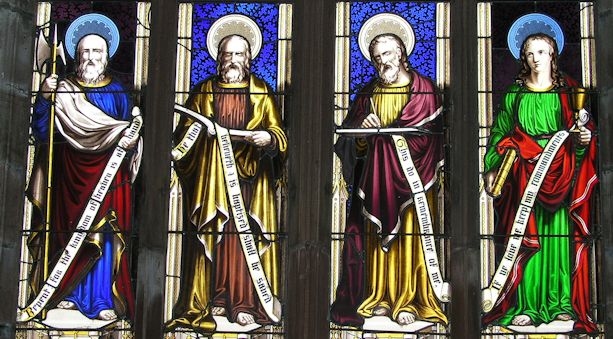Page 10 of 11
The Chalice of Magdalene
The Final Clue
Graham spent a great deal of time having the corner of the church around the window thoroughly examined with scientific equipment to see if anything was hidden there. Nevertheless, the results proved negative. It seemed that if anything had been secreted in the south-east corner of Hodnet Church it had long ago been found. Ultimately, however, Graham hit upon a new line of investigation. He discovered that the window had been designed, donated and installed in the church by none other than Thomas Wright – the very man who had set the clues – in 1855, the same year that he had published his enigmatic poem. Perhaps it was the window itself that was important. Maybe this was a final clue that the code had been leading to, rather than the hiding place itself. If so, what did it mean?
Suddenly, Graham saw something that struck a familiar chord. Above the heads of the men depicted in the window were images of the Christian symbols for the four gospels they are accredited with writing – an angel, a lion, a bull, and an eagle. These were exactly the same figures represented by the statues that had stood in the labyrinth of caves at Hawkstone Park. Following Wright’s trail of clues, the seeker had to pass through the cavern where the statues were. Surely this was no coincidence. Was this Thomas Wright’s final clue? That the Marian Chalice had been hidden in one of these four statues? But which one? Each of the gospel writers was depicted holding the book they had written but one of them – St. John - also held a chalice. It was a chalice – the Chalice of Mary Magdalene – that the clues were apparently leading to.
The four figures and the images depicted higher in the window above their heads.


It was then that Graham realized that there was something strange about the St. John figure.
It seemed to be a woman. The other gospel writers are all depicted with beards, whereas the John figure is both clean shaven and has decidedly feminine features. What's more, the figure seems to be wearing a woman's gown which looks to be covering breasts. Could this figure holding the chalice, the final clue to the cup's whereabouts, actually be a thinly disguised Mary Magdalene?

Is this a depiction of Saint John or an image of Mary Magdalene?
Either way, this was the figure in the very corner of the church, and above it was the cornerstone seemingly alluded to in one of the Psalm verses. Directly beneath the cornerstone and above the figure’s head was the image of the eagle. Was the Marian Chalice hidden in the eagle statue in the White Cliff caves?








